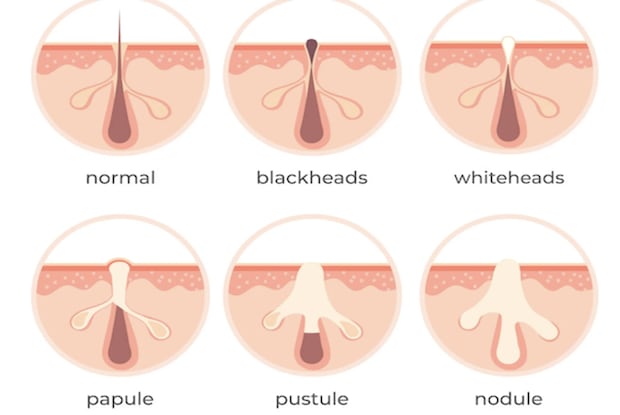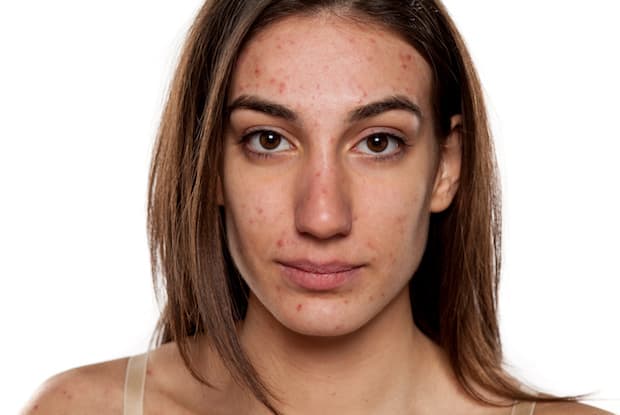Table of Contents
Understanding Acne
Acne is one of the most common skin conditions in the world. Over 50 million Americans experience acne every year. This condition does not just affect adolescents, it can occur to anyone. Acne usually begins once you go through puberty, but it may resolve itself or continue in flare-ups into adulthood. Over 85 percent of people in the United States experience acne between the ages of 12 and 24. [1]
The skin is dotted with thousands of pores that connect to oil glands under the skin. Follicles (liquid-secreting sacs) then connect the glands to pores. Sebum is an oily liquid that often clogs this delicate infrastructure. The sebum moves dead skill cells through the follicles, and acne may occur when these follicles clog. Clogged pores may also be caused by:
- Ingrown hairs
- Hormones
- Bacteria
Because acne is so common, there are several medications available to help people with symptoms. Drugs that contain vitamin A assist in skin healing, so medications like Retin-A gel, cream, and micro gel pump (tretinoin) can help with acne treatment. Many people may think that there is only one type of acne, but there are several varieties that may affect people. Read on to learn more about the different types of acne and the treatments available. [1]

Blackheads
Blackheads, also known as open comedones, are small bumps that appear on the skin. This is a mild form of acne and typically occurs on the back, chest, arms, shoulders, and neck. Blackheads occur when they form a plug at the opening of a hair follicle. A bump filled with dead skin cells and oil, and this bump will appear black because the clogged follicle is open to the air.
Because they are black, they are easy to spot on the skin. This is a non-inflammatory type of acne, so they are not painful or inflamed. These bumps will be slightly raised on the skin. You may be able to pop these blackheads yourself, but this increases your risk for a skin infection. A professional with a round loop extractor can extract the clog. Risk factors for blackheads include:
- Producing too much body oil
- Taking corticosteroids, lithium, or androgens
- A buildup of bacteria on the skin
- Menstruation
- Taking birth control pills [2]
Whiteheads
Whiteheads are similar to blackheads because they are also non-inflammatory and do not produce any pain. Blackheads are open comedones, and whiteheads are closed comedones. Whiteheads are described as closed because the skin closes over the clogged follicle. This leaves a raised bump that is typically the same color as your skin. Being closed makes whiteheads more difficult to treat.
Whiteheads can be prevented with a proper skin-cleansing routine and the use of a topical retinoid, like Retin-A cream. Wearing sunscreen every day will also help protect sensitive skin. It is best not to pick at whiteheads if they appear because it can leave permanent scars. Genetics and increased oil production play a large role in the development of whiteheads. These bumps also commonly appear on the body's high-friction areas, like the chin from a strap from a bike helmet. [3]

Papules and Pustules
All of the following acne varieties are inflammatory and can cause pain and redness. Papules are small red bumps, less than five millimeters in diameter. Papules do not have a center of pus and should not be popped. In many cases, papules are caused by bacteria and dead skin accumulation in the follicles, so popping them can cause the bacteria to spread. Common risk factors for papules include bacteria, excess oil production, and excess androgen (male sex hormone) activity. Continual stress and a high-sugar diet may also contribute to the development of papules. [4]
In many cases, papules will develop into pustules. Dermatologists qualify the transition of the papule to pustule when pus develops. Pustules occur when the walls around your pore break down, causing these bumps to stand out from the skin and appear red. Because pus is present, the tops of the pustules have yellow or whiteheads. [5]
Nodules
Nodular acne is a painful condition, resulting in small bumps underneath the skin. These bumps may be red and slightly skin-toned. Nodular acne is a severe skin condition that often results in permanent scars. If the nodules are not properly treated, then constant inflammation can affect surrounding skin cells, leading to darkened skin spots. These dark spots may persist for years. Popping these nodules can lead to scabbing and increase the likelihood of scars.
A good skincare routine is vital with nodular acne. Over-the-counter products usually do not help nodular acne, so you will likely be prescribed prescription antibiotics and topical acne products. Antibiotics will help kill bacteria trapped in the pores, and salicylic acid drugs can help dry out dead skin cells and oil in the nodule. If these treatments do not help, you may undergo the following procedures at a medical office:
- Acne drainage and extraction
- Blue light therapy
- Chemical peels
- Laser therapy [6]

Cysts
Along with nodules, cystic acne is one of the most severe forms of acne. Cystic acne is the largest form of acne and creates red, painful breakouts deep in the skin. This occurs when the follicle becomes clogged and leads to trapped bacteria. Trapped bacteria can create an infection deep into the skin, creating a bump full of pus. Pus-filled bumps are called cysts that may hurt or itch. When these cysts burst, the infection can spread and lead to more cysts on the body.
You are more likely to get this type of acne if a parent also experienced cystic acne. Cystic acne is more common in men than in women. This type of acne can be chronic and affect large areas of the skin. Cystic acne may occur because of:
- A woman’s menstrual cycle
- Menopause
- Polycystic ovary syndrome
- High humidity and sweating
- Tight clothing
- Some skincare products or makeup
Vitamin A medications can help cysts, but you may need more intensive treatments like steroid injections, oral antibiotics, or birth control pills for women to regulate hormones. Talk to your doctor to decide the right acne medication for you. [7]
The content in this article is intended for informational purposes only. This website does not provide medical advice. In all circumstances, you should always seek the advice of your physician and/or other qualified health professionals(s) for drug, medical condition, or treatment advice. The content provided on this website is not a substitute for professional medical advice, diagnosis, or treatment.
